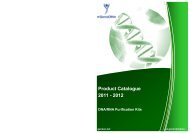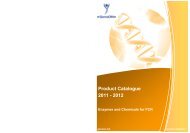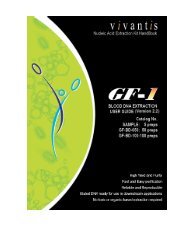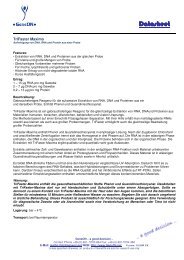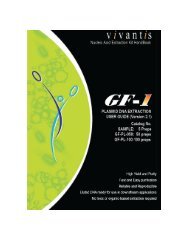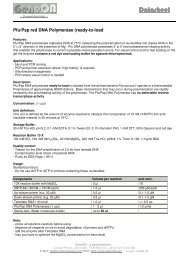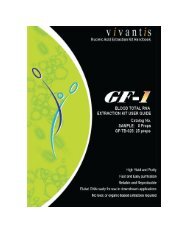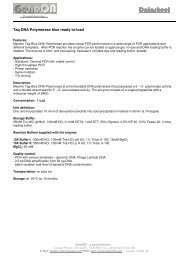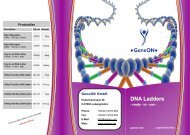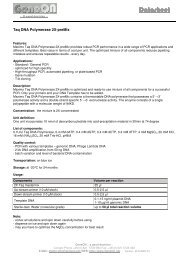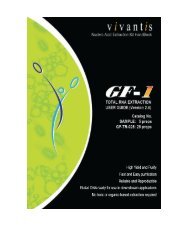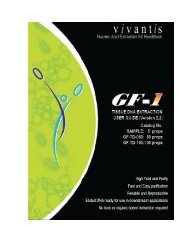Food DNA isolation miniprep kit: Manual
Food DNA isolation miniprep kit: Manual
Food DNA isolation miniprep kit: Manual
Create successful ePaper yourself
Turn your PDF publications into a flip-book with our unique Google optimized e-Paper software.
Introduction<br />
The GF-1 <strong>Food</strong> <strong>DNA</strong> Extraction Kit is designed for rapid and efficient purification of<br />
genomic <strong>DNA</strong> from up to 100mg of raw or processed food from plant, animal or mixed<br />
origins. This <strong>kit</strong> uses a specially-treated glass filter membrane fixed into a column to<br />
efficiently bind <strong>DNA</strong> in the presence of high salt. The <strong>kit</strong> applies the principle of a minicolumn<br />
spin technology and the use of optimized buffers to ensure that only <strong>DNA</strong> is isolated<br />
while proteins and other impurities, additives, preservatives are removed during the<br />
subsequent washing steps. High purity genomic <strong>DNA</strong> is then eluted in water or low salt<br />
buffers, ready to use in many routine molecular biology applications such as PCR and<br />
restriction enzyme digestion. This <strong>kit</strong> is suitable for use in GMO testing and has been tested<br />
on various raw samples such as soybean, maize and processed foods (soy flour, soymilk, soy<br />
sauce, sausage, meat, cereal meal, and cocoa).<br />
Kit components<br />
Product<br />
Catalog No.<br />
5 Preps<br />
SAMPLE<br />
25 Preps<br />
GF-FE-025<br />
Components<br />
GF-1 columns 5 25<br />
Collection tubes 5 25<br />
<strong>Food</strong> Lysis Buffer (Buffer<br />
5ml<br />
25ml<br />
FL)<br />
<strong>Food</strong> <strong>DNA</strong> Binding Buffer<br />
4ml<br />
20ml<br />
(Buffer FB)<br />
Wash Buffer 1<br />
1.5ml<br />
7ml<br />
(concentrate)*<br />
Wash Buffer 2<br />
1.8ml<br />
9ml<br />
(concentrate)*<br />
Elution Buffer 1ml 2X2ml<br />
Proteinase K* 0.11ml 0.55ml<br />
Handbook 1 1<br />
* Please refer to Reconstitution of Solutions and Storage and Stability before using this <strong>kit</strong>.<br />
The GF-1 <strong>Food</strong> <strong>DNA</strong> Extraction Kit is available as 25 purifications per <strong>kit</strong>.<br />
The reagents and materials provided with the <strong>kit</strong> are for research purposes only.
Additional Materials to be Supplied by User<br />
Absolute Ethanol (>95%)<br />
RNase A (DNase-free, 20mg/ml)<br />
Reconstitution of Solutions<br />
The bottle labeled Wash Buffer 1 and Wash Buffer 2 contain concentrated buffers<br />
to be diluted with absolute ethanol (>95%) before use.<br />
For SAMPLE (5 preps),<br />
Add 1.5ml of absolute ethanol into the bottle labeled Wash Buffer 1.<br />
Add 4.2ml of absolute ethanol into the bottle labeled Wash Buffer 2.<br />
For GF-FE-025 (25 preps),<br />
Add 7ml of absolute ethanol into the bottle labeled Wash Buffer 1.<br />
Add 21ml of absolute ethanol into the bottle labeled Wash Buffer 2.<br />
Store Wash Buffer at room temperature with bottle capped tight after use.<br />
Storage and Stability<br />
• Store all solutions at 20°C - 30°C.<br />
• Store Proteinase K at -20°C.<br />
• Kit components are guaranteed to be stable for 12 months from the date of<br />
Buffer FB may exhibit salt precipitation due to cold temperature. If this occurs, simply<br />
bottle at 55°C - 65°C with occasional mixing until precipitate is completely dissolved.<br />
Chemical Hazard<br />
Buffer FB and Wash Buffer 1 contain guanidine salts which can be harmful when with skin<br />
or swallowed. Always wear gloves and practice standard safety precautions. Do NOT<br />
disinfect guanidine or extraction waste in solutions containing bleach or any other. To clean<br />
any items contaminated with the reagent, simply soak in detergent remove all traces of<br />
guanidine before cleaning with bleach or acidic solutions.
Procedures<br />
Reminder<br />
• All steps are to be carried out at room temperature unless stated otherwise<br />
• Wash Buffer 1 and Wash Buffer 2 (concentrate) have to be diluted with absolute<br />
ethanol before use. Please refer to Reconstitution of Solutions.<br />
• If precipitation forms in Buffer FB, incubate at 55°C - 65°C with occasional mixing<br />
until precipitate is completely dissolved.<br />
Pre-set waterbath to 65°C.<br />
Pre-heat Elution Buffer at 65°C.<br />
1. Sample preparation and cell lysis<br />
a. Solid Sample<br />
♦ Grind the sample into powder form using commercial homogenizer or liquid<br />
nitrogen with pestle and mortal.<br />
Lysis is more efficient when the sample is well homogenized. Homogenization method used<br />
depends on the type of sample. In some cases, homogenization is not needed but complete<br />
suspension is necessary for efficient lysis for samples such as soy flour and cocoa powder<br />
♦ Place 100-200mg of ground sample into a clean microcentrifuge tube. Add 700µl<br />
Buffer FL and 20µl Proteinase K into the sample. Mix thoroughly by vortexing to<br />
obtain a homogenous solution. Incubate at 65°C for 30 min with occasional mixing<br />
during incubation to ensure thorough lysis of the sample.<br />
Use up to 100mg for hygroscopic samples e.g. flour, dried plant, etc. Users may need to<br />
increase the volume of Buffer FL until the sample is semi-fluid like.<br />
b. Liquid sample<br />
♦ Transfer 400µl of sample directly into a clean microcentrifuge tube. Add 300µl<br />
Buffer FL and 20µl Proteinase K into the sample. Mix thoroughly by vortexing to<br />
obtain a homogenous solution. Incubate at 65°C for 30 min with occasional mixing<br />
during incubation to ensure thorough lysis of the sample.
Optional: Removal of RNA<br />
If RNA-free <strong>DNA</strong> is required, add 20µl of RNase A (DNase-Free, 20mg/ml). Mix and<br />
incubate at 37°C for 10 min.<br />
2. Homogenization<br />
Centrifuge at 12,000 x g for 5 min to pellet the cell debris and contaminants. Transfer<br />
450µl of cleared supernatant to a clean microcentrifuge tube. Add 1.5 volumes of Buffer<br />
FB (~680µl without RNase A treatment, ~710µl with RNase A treatment) and mix<br />
thoroughly by pulsed vortexing until a homogenous solution is obtained. Incubate at 65°C<br />
for 10 min.<br />
When transferring the supernatant, avoid touching the pellet and the layer of contaminants on top<br />
of the solutions if any. If the supernatant transferred is less than 450µl, adjust the volume of<br />
Buffer FB to be added proportionately.<br />
3. Addition of ethanol<br />
Add 350µl of absolute ethanol. Mix immediately and thoroughly by pulsed-vortexing to<br />
obtain homogenous solution. Centrifuge at 5,000 x g for 1 min.<br />
Mix immediately to prevent any uneven precipitation of nucleic acid due to high local ethanol<br />
concentrations.<br />
4. Loading to column<br />
Attention! Tips for Higher Yield<br />
In order to obtain maximum yield, we strongly recommend users to fix the orientation of the<br />
column during centrifugation at all times. We recommend users to place the column which has a<br />
triangle mark on the edge, at a fixed position during centrifugation<br />
Transfer approximately 750µl of supernatant into a column assembled in a clean<br />
collection tube (provided). Centrifuge at 5,000 x g for 1 min. Discard flow through.<br />
Repeat for the remaining sample from step 3.
5. Column washing 1<br />
Wash the column with 500µl Wash Buffer 1 and centrifuge at 5,000 x g for 1 min.<br />
Discard through.<br />
Ensure that ethanol has been added into the Wash Buffer 1 before use (refer to Reconstitution of<br />
Solutions).<br />
6. Column washing 2<br />
Wash the column with 500µl Wash Buffer 2 and centrifuge at 5,000 x g for 1 min.<br />
Discard Flow through. Wash the column again with 500µl Wash Buffer 2 and centrifuge<br />
at maximum speed for 3 min.<br />
Ensure that ethanol has been added into the Wash Buffer 2 before use (refer to Reconstitution of<br />
Solutions). Ensure centrifugation for 3 min to remove ethanol completely.<br />
7. <strong>DNA</strong> Elution<br />
Place the column into a clean microcentrifuge tube. Add 50-100µl of preheated Elution<br />
Buffer, TE buffer or sterile water directly onto column membrane and stand for 2 min.<br />
Centrifuge at 5,000 x g for 1 min to elute <strong>DNA</strong>. Store <strong>DNA</strong> at 4°C or -20°C.<br />
Ensure that the Elution Buffer is dispensed directly onto the center of the membrane for complete<br />
elution. TEBuffer can also elute <strong>DNA</strong> although EDTA may inhibit subsequent enzymatic<br />
reactions. If water is used for eluting <strong>DNA</strong>, maximum elution efficiency is achieved between<br />
pH7.0 and 8.5. Store <strong>DNA</strong> at -20°C as <strong>DNA</strong> may degrade in the absence of a buffering agent.<br />
Note: The recommended amplicon length for PCR analysis is
Troubleshooting<br />
Please note that by not adhering to the recommended protocols, unsatisfactory results related<br />
to yield and quality of <strong>DNA</strong> may occur. If problems arise, please refer to the following:<br />
Problem Possibility Suggestions<br />
Low <strong>DNA</strong> yield<br />
Low <strong>DNA</strong> yield<br />
Sample homogenization is<br />
not sufficient<br />
Insufficient sample lysis<br />
Addition of ethanol was<br />
neglected<br />
Proteinase K activity is<br />
decreased<br />
Wash Buffer 1 and Wash<br />
Buffer 2 are applied in<br />
wrong order<br />
Wash Buffer 1 and Wash<br />
Buffer 2 are reconstituted<br />
wrongly<br />
Column not placed at fixed<br />
orientation during<br />
centrifugation<br />
Grind the samples into fine<br />
powder in liquid nitrogen.<br />
Mix the sample thoroughly with<br />
Buffer FL and Proteinase K.<br />
Incubation time may be<br />
extended up to 2 hours at 65°C.<br />
Reduce the amount of starting<br />
material.<br />
If sample used is highly<br />
hygroscopic, increase the<br />
volume of Buffer FL until the<br />
sample is semi-fluid like.<br />
Repeat purification with a new<br />
sample.<br />
Ensure that Proteinase K is<br />
stored at -20°C.<br />
Ensure that Wash Buffer 1 is<br />
applied before Wash Buffer 2.<br />
Repeat purification with a new<br />
sample.<br />
Please refer to the<br />
‘Reconstitution of Solution’.<br />
Repeat purification with a new<br />
blood sample.<br />
Place the column which has a<br />
triangle mark on the edge, at a<br />
fixed position during<br />
centrifugation at all times.
Problem Possibility Suggestions<br />
Column is not dried before<br />
addition of Elution Buffer<br />
Elution is not performed<br />
properly<br />
Ensure that column is spun<br />
dried at maximum speed for 3<br />
minutes after addition of Wash<br />
Buffer 2.<br />
Pre-heat Elution Buffer at<br />
65°C -70°C before eluting <strong>DNA</strong>.<br />
Low purity (A 260/280)<br />
Poor performance of<br />
eluted <strong>DNA</strong> in<br />
downstream<br />
applications<br />
Proteinase K activity is<br />
decreased<br />
Incomplete sample lysis<br />
Wash Buffer 1 is not<br />
applied<br />
Eluted <strong>DNA</strong> contains traces<br />
of ethanol<br />
Eluted <strong>DNA</strong> contains traces<br />
of inhibitors<br />
Incubate at room temperature<br />
for 2 minutes after addition of<br />
Elution Buffer.<br />
Ensure that Elution Buffer used<br />
is a low salt buffer or water<br />
with pH range of pH 7.0- 8.5<br />
Please refer to problem "Low<br />
<strong>DNA</strong> yield"<br />
Please refer to problem "Low<br />
<strong>DNA</strong> yield"<br />
Ensure that Wash Buffer 1 is<br />
applied to the column before<br />
addition of Wash Buffer 2.<br />
Centrifuge the column at<br />
maximum speed for 3 min<br />
during second washing of<br />
column with Wash Buffer2.<br />
Ensure that washing steps are<br />
carried out with Wash Buffer 1<br />
and Wash Buffer2<br />
TE buffer is used to elute<br />
<strong>DNA</strong>. EDTA in TE buffer<br />
may inhibit subsequent<br />
enzymatic reaction<br />
Use Elution Buffer or water<br />
with a pH<br />
range of 7.0 - 8.5



